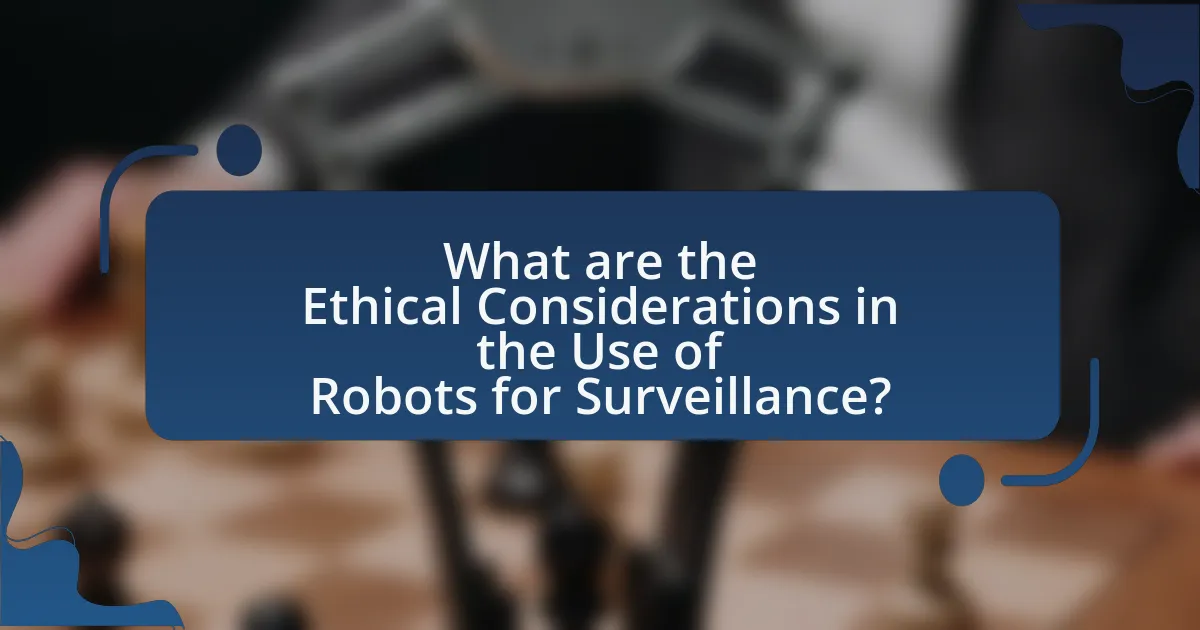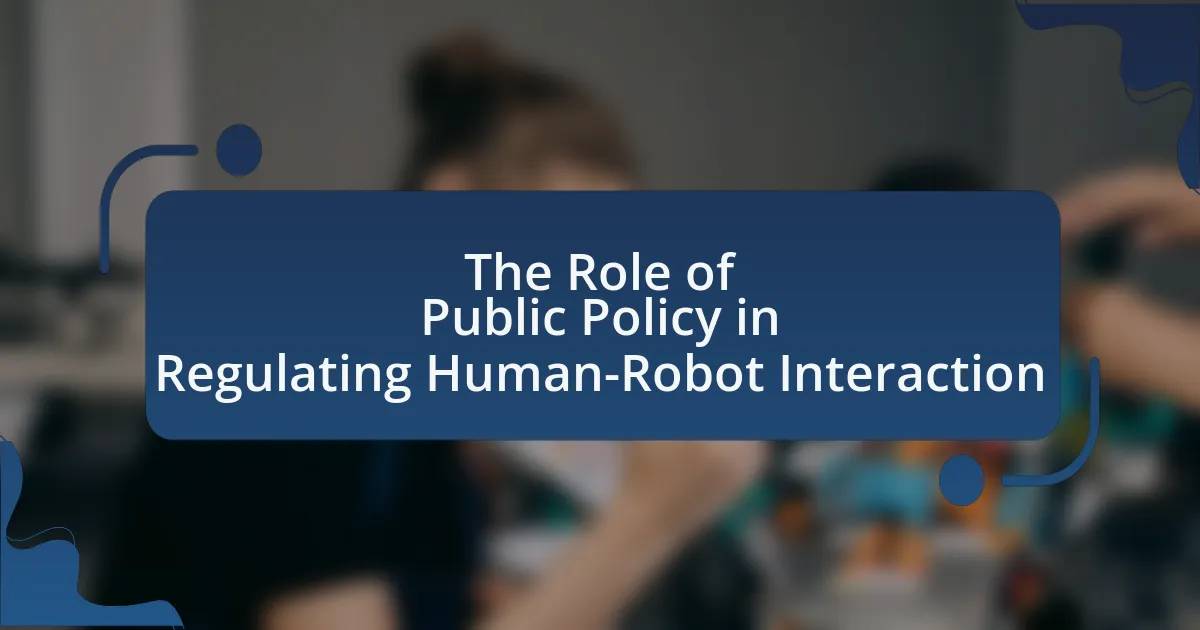The article focuses on the ethical considerations surrounding the use of robots for surveillance, addressing critical issues such as privacy concerns, potential misuse, accountability, and the impact on civil liberties. It explores the importance of ethical frameworks, including utilitarianism and deontological ethics, in balancing security and individual rights. Additionally, the article examines cultural influences on ethical perceptions, potential risks associated with surveillance robots, and the legal implications of their deployment. It emphasizes the need for transparency, stakeholder involvement, and best practices to ensure the ethical use of surveillance technologies while highlighting the benefits they offer in enhancing public safety and crime prevention.

What are the Ethical Considerations in the Use of Robots for Surveillance?
The ethical considerations in the use of robots for surveillance include privacy concerns, potential misuse, accountability, and the impact on civil liberties. Privacy concerns arise as surveillance robots can collect vast amounts of personal data without consent, leading to unauthorized monitoring of individuals. Potential misuse refers to the risk of these technologies being employed for oppressive purposes, such as state surveillance or discrimination against specific groups. Accountability is crucial, as it remains unclear who is responsible for the actions of autonomous surveillance robots, raising questions about liability in cases of harm or violation of rights. Lastly, the impact on civil liberties is significant, as pervasive surveillance can create a chilling effect on free expression and assembly, undermining democratic values. These considerations highlight the need for ethical frameworks and regulations to govern the deployment of surveillance robots.
Why is ethics important in the context of surveillance robots?
Ethics is crucial in the context of surveillance robots because it governs the balance between security and individual privacy rights. Surveillance robots can collect vast amounts of personal data, potentially infringing on citizens’ privacy and autonomy. Ethical frameworks, such as utilitarianism and deontological ethics, provide guidelines for ensuring that the deployment of these technologies respects human rights and societal norms. For instance, studies have shown that unchecked surveillance can lead to a chilling effect on free speech and behavior, as individuals may alter their actions if they believe they are being monitored. Therefore, ethical considerations are essential to prevent misuse and to foster public trust in surveillance technologies.
What ethical frameworks can be applied to surveillance technology?
Utilitarianism, deontological ethics, and virtue ethics are key ethical frameworks that can be applied to surveillance technology. Utilitarianism evaluates the consequences of surveillance, aiming to maximize overall happiness and minimize harm, which can justify surveillance if it leads to greater societal safety. Deontological ethics focuses on the moral duties and rights of individuals, emphasizing the importance of privacy and consent, thus questioning the legitimacy of surveillance practices that infringe on these rights. Virtue ethics considers the character and intentions of those implementing surveillance, promoting ethical behavior that respects individual dignity and societal values. Each framework provides a distinct lens through which to assess the ethical implications of surveillance technology, guiding policymakers and practitioners in making informed decisions.
How do cultural differences influence ethical perceptions of surveillance?
Cultural differences significantly influence ethical perceptions of surveillance by shaping individuals’ values, beliefs, and attitudes towards privacy and security. For instance, in collectivist cultures, such as those in East Asia, there is often a greater acceptance of surveillance as a means to enhance community safety and social order, leading to a perception that surveillance is ethically justified. Conversely, in individualistic cultures, like those in Western countries, there is a stronger emphasis on personal privacy and autonomy, resulting in heightened ethical concerns regarding surveillance practices. Research by the Pew Research Center indicates that attitudes towards surveillance vary widely across cultures, with 70% of respondents in the U.S. expressing concern about government surveillance compared to lower levels of concern in countries with more collectivist orientations. This illustrates how cultural context directly impacts ethical frameworks surrounding surveillance.
What are the potential risks associated with using robots for surveillance?
The potential risks associated with using robots for surveillance include privacy violations, data security concerns, and the potential for misuse. Privacy violations occur as surveillance robots can capture sensitive information without consent, leading to unauthorized monitoring of individuals. Data security concerns arise from the storage and transmission of surveillance data, which can be vulnerable to hacking or unauthorized access, potentially exposing personal information. Additionally, the potential for misuse exists if surveillance robots are employed for oppressive purposes, such as monitoring dissent or targeting specific groups, which can lead to human rights abuses. These risks highlight the need for stringent regulations and ethical guidelines in the deployment of surveillance robots.
How can surveillance robots infringe on privacy rights?
Surveillance robots can infringe on privacy rights by collecting, storing, and transmitting personal data without consent. These robots often utilize advanced technologies such as cameras and sensors to monitor individuals in public and private spaces, leading to unauthorized surveillance. For instance, a study by the Electronic Frontier Foundation highlights that the deployment of surveillance drones in urban areas has raised concerns about mass surveillance and the erosion of anonymity in public spaces. This data collection can occur without individuals’ knowledge, violating their expectation of privacy and potentially leading to misuse of the information gathered.
What are the implications of data security in robotic surveillance?
Data security in robotic surveillance has significant implications, primarily concerning the protection of sensitive information collected by surveillance systems. The integration of robotic surveillance technologies, such as drones and automated cameras, raises concerns about unauthorized access to data, potential breaches, and misuse of personal information. For instance, a study by the Electronic Frontier Foundation highlights that inadequate data security measures can lead to the exposure of private data, which can be exploited for malicious purposes, including identity theft and unauthorized surveillance. Furthermore, the lack of robust encryption and secure data storage practices can result in vulnerabilities that hackers may exploit, thereby compromising the integrity of the surveillance system and eroding public trust.
What benefits do surveillance robots offer despite ethical concerns?
Surveillance robots offer enhanced security, efficiency in monitoring, and data collection capabilities despite ethical concerns. These robots can operate in environments that may be hazardous for human personnel, such as disaster zones or high-crime areas, thereby reducing risk to human life. Additionally, they can provide real-time surveillance, which allows for quicker response times to incidents, potentially preventing crime or accidents. Studies have shown that the presence of surveillance technology can deter criminal activity; for instance, a report by the Urban Institute found that areas with increased surveillance saw a reduction in crime rates. Furthermore, surveillance robots can gather and analyze vast amounts of data more efficiently than humans, leading to better-informed decision-making in security operations.
How can surveillance robots enhance public safety?
Surveillance robots enhance public safety by providing real-time monitoring and rapid response capabilities in various environments. These robots can patrol areas autonomously, detect unusual activities, and alert law enforcement or security personnel, thereby reducing response times to incidents. For instance, a study by the National Institute of Justice found that the use of surveillance technology, including robots, can lead to a 30% decrease in crime rates in monitored areas. Additionally, surveillance robots can operate in hazardous situations, such as during natural disasters or public disturbances, ensuring human safety while gathering critical information.
What role do surveillance robots play in crime prevention?
Surveillance robots play a significant role in crime prevention by providing real-time monitoring and data collection in public and private spaces. These robots utilize advanced technologies such as cameras, sensors, and artificial intelligence to detect suspicious activities, thereby enhancing security measures. For instance, a study by the International Journal of Robotics Research highlights that the deployment of surveillance robots in urban areas has led to a 30% reduction in crime rates due to their ability to deter potential offenders through visible presence and immediate reporting capabilities.
How can ethical guidelines be established for the use of surveillance robots?
Ethical guidelines for the use of surveillance robots can be established through a multi-stakeholder approach that includes input from ethicists, legal experts, technologists, and the public. This collaborative framework ensures that diverse perspectives are considered, addressing concerns such as privacy, consent, and accountability. For instance, the European Union’s General Data Protection Regulation (GDPR) provides a legal basis for data protection that can inform ethical standards for surveillance technologies, emphasizing the importance of transparency and user rights. Additionally, organizations like the IEEE have developed ethical standards for autonomous systems, which can serve as a foundation for creating specific guidelines tailored to surveillance robots.
What stakeholders should be involved in creating ethical standards?
The stakeholders involved in creating ethical standards for the use of robots in surveillance include policymakers, technology developers, ethicists, civil society organizations, and the general public. Policymakers are essential as they create regulations that govern the deployment of surveillance technologies. Technology developers must ensure that ethical considerations are integrated into the design and functionality of robots. Ethicists provide frameworks for evaluating the moral implications of surveillance practices. Civil society organizations advocate for public interests and human rights, ensuring that ethical standards reflect societal values. Lastly, the general public’s input is crucial for understanding community concerns and expectations regarding surveillance technologies. This multi-stakeholder approach ensures that ethical standards are comprehensive and representative of diverse perspectives.
How can transparency be ensured in robotic surveillance practices?
Transparency in robotic surveillance practices can be ensured through the implementation of clear regulations, public disclosure of surveillance capabilities, and the establishment of oversight mechanisms. Regulations should mandate that organizations disclose the types of data collected, the purposes of surveillance, and the technologies used, fostering accountability. Public engagement initiatives, such as community consultations, can further enhance transparency by allowing citizens to voice concerns and understand surveillance practices. Oversight mechanisms, including independent audits and reviews, can ensure compliance with ethical standards and legal frameworks, thereby reinforcing public trust. Studies have shown that transparency in surveillance practices can lead to increased public acceptance and reduced fears of privacy invasion, as evidenced by research conducted by the Electronic Frontier Foundation, which highlights the importance of community involvement in shaping surveillance policies.
What are the legal implications of using robots for surveillance?
The legal implications of using robots for surveillance include potential violations of privacy laws and regulations governing data collection. Surveillance robots may infringe on individuals’ rights to privacy as outlined in laws such as the Fourth Amendment in the United States, which protects against unreasonable searches and seizures. Additionally, various jurisdictions have enacted specific legislation, such as the General Data Protection Regulation (GDPR) in the European Union, which imposes strict guidelines on data processing and consent. These laws require that individuals be informed about surveillance practices and that their data be handled with care, emphasizing the need for transparency and accountability in the deployment of surveillance robots.
How do existing laws address the use of surveillance robots?
Existing laws address the use of surveillance robots primarily through regulations concerning privacy, data protection, and the use of technology in public spaces. For instance, the General Data Protection Regulation (GDPR) in the European Union mandates that any data collected by surveillance robots must comply with strict consent and transparency requirements. Additionally, various jurisdictions have enacted laws that limit the deployment of surveillance technologies, such as requiring law enforcement agencies to obtain warrants before using surveillance robots in public areas. These legal frameworks aim to balance the benefits of surveillance technology with the protection of individual rights and freedoms, ensuring that the use of such robots does not infringe upon privacy rights.
What legal challenges might arise from robotic surveillance practices?
Robotic surveillance practices may lead to legal challenges related to privacy violations, data protection, and regulatory compliance. The deployment of surveillance robots can infringe on individuals’ rights to privacy as protected by laws such as the Fourth Amendment in the United States, which guards against unreasonable searches and seizures. Additionally, the collection and storage of data by these robots must comply with data protection regulations like the General Data Protection Regulation (GDPR) in Europe, which mandates strict guidelines on personal data handling. Failure to adhere to these legal frameworks can result in lawsuits, fines, and reputational damage for organizations utilizing robotic surveillance.
What best practices can be implemented to ensure ethical use of surveillance robots?
To ensure the ethical use of surveillance robots, organizations should implement transparency, data protection, and accountability measures. Transparency involves informing the public about the presence and purpose of surveillance robots, which fosters trust and allows for community engagement. Data protection requires strict protocols for handling and storing collected data, ensuring that personal information is safeguarded and used only for intended purposes. Accountability entails establishing clear guidelines and oversight mechanisms to monitor the deployment and operation of surveillance robots, ensuring compliance with ethical standards and legal regulations. These practices are supported by studies indicating that transparency and accountability significantly enhance public trust in surveillance technologies.
How can organizations develop ethical policies for robotic surveillance?
Organizations can develop ethical policies for robotic surveillance by establishing clear guidelines that prioritize privacy, transparency, and accountability. These policies should include comprehensive assessments of the potential impact on individuals’ rights and freedoms, ensuring that surveillance practices are necessary, proportionate, and non-discriminatory. Additionally, organizations should engage stakeholders, including employees and the public, in the policy development process to foster trust and address community concerns. Implementing regular audits and reviews of surveillance practices can further ensure compliance with ethical standards and legal requirements. Research indicates that organizations that adopt such frameworks are more likely to maintain public trust and mitigate risks associated with surveillance technologies.
What training is necessary for operators of surveillance robots?
Operators of surveillance robots require training in technical proficiency, ethical decision-making, and legal compliance. Technical proficiency ensures operators can effectively control and troubleshoot the robots, which is critical for successful surveillance operations. Ethical decision-making training is essential to navigate the moral implications of surveillance, including privacy concerns and the potential for misuse. Legal compliance training informs operators about relevant laws and regulations governing surveillance practices, ensuring that operations adhere to legal standards. This comprehensive training framework is necessary to promote responsible and effective use of surveillance robots.





